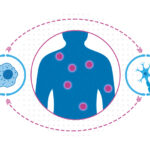Acute flaccid myelitis (AFM): What parents need to know

If you’re a parent, chances are you’ve heard the recent news reports about acute flaccid myelitis, or AFM. As of September 2022, 13 cases of AFM have been confirmed in the U.S. according to the Center for Disease Control (CDC), and experts expect that number could rise. For reasons that are still unclear, outbreaks have occurred every two years since 2014.
With the current uptick in Enterovirus D68 (EV-D68) cases resulting in more pediatric hospitalizations, the ongoing COVID-19 pandemic and a related complication called multisystem inflammatory syndrome in children (MIS-C), AFM may seem like one more concern for families. To help give some context, we spoke with Dr. Leslie Benson, an attending physician in the Department of Neurology at Boston Children’s Hospital.
What is acute flaccid myelitis?
AFM is a condition that affects the spinal cord or parts of the brainstem, mostly in children. It can cause sudden weakness and paralysis, ranging from weakness of the facial muscles, to limb weakness, to weakened breathing. It often starts during or just after a mild respiratory illness or fever. People describe AFM as ‘polio-like’ because, like polio, AFM affects the motor nerves in the spinal cord.

What causes this condition?
AFM appears to be linked to several fairly common viruses, including enterovirus D68, enterovirus A71, and others. Direct viral infection of the spinal cord or parts of the brainstem is most likely responsible for the clusters of patients that have been seen in the fall every other year since 2014. However, an autoimmune condition called MOG antibody associated disease has been reported to cause very similar symptoms.
We don’t yet know why some people with these viruses develop AFM while most don’t. A group of researchers are currently doing genetic testing in children who have developed AFM and their family members to see if there’s something in certain people’s genes that makes them predisposed to AFM.
Who gets AFM?
Most cases are in children, particularly in younger kids. The average age is around 5 years, though AFM has also occurred in older children and adults.
What are the symptoms of AFM?
The early signs of AFM include inability to move one of the limbs or the face, or pain in the affected limb, neck or back. If your child has any of these symptoms, it makes sense to have them checked out by their primary care physician. Although it’s a scary illness for parents to think about, it’s important to remember that it’s very rare.
Is there any way to prevent AFM?
Because we’re still learning more about AFM, the only prevention tool we know of right now is good infection control. This means taking the same precautions you would to avoid colds and the flu, such as coughing into your elbow, washing your hands often and avoiding close contact with those who are sick. The same precautions, including social distancing, that are being taken to prevent COVID-19 are likely to help prevent AFM.
Will there be more cases this year?
Although we can’t say for certain, experts think that — based on past experience — there may be a spike in AFM cases between August and November this year. At this time, we don’t know how the COVID-19 pandemic may affect the spread of the viruses that could cause AFM. There might be fewer cases, or the outbreak could be delayed. There’s a lot of effort being put forward in trying to learn more about this condition. The U.S. Centers for Disease Control has stepped up efforts to spread awareness, monitor for cases, and learn more about this condition in collaboration with National Institutes of Health, experts, and advocacy groups across the country.
Related: The mystery of Jane’s left shoulder: Acute flaccid myelitis
Learn more about the Department of Neurology.
Related Posts :
-

The mystery of Jane’s left shoulder: Acute flaccid myelitis
When 5-year-old Jane Morehead tumbled off her bike in May 2017, it didn’t seem like a big deal. Jane’s ...
-

From injury to backflips: A path to recovery for gymnasts
Gymnasts can create the illusion that gravity doesn’t exist. As they spring from one acrobatic skill into the next, ...
-

A deeper understanding of inflammatory pain could reveal new solutions
Non-steroidal anti-inflammatory drugs (NSAIDs) such as ibuprofen are the main go-to for inflammatory pain caused by wounds, infection, sunburn, arthritis, ...
-

Jumping higher, spinning faster: Max’s figure skating story
Thousands of fans around the globe have watched it, but very few people can do it. The quadruple Salchow, also ...





